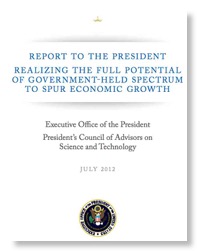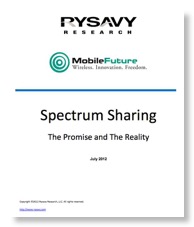Battling Spectrum Reports: Mobile Future vs. PCAST
On Sunday 7/15 Mobile Future released a report entitled “Spectrum Sharing: The Promise and The Reality”, almost certainly in anticipation of the final PCAST report that was released on Friday 7/20 as had been previously announced. The PCAST report was discussed here previously when a public briefing discussed its basic findings. A year ago we introduced readers to Mobile Future in a post entitled “New Cellular Advocacy Group Trivializes Spectrum Policy Issues”. Mobile Future’s membership includes Alcatel-Lucent, AT&T, Ericsson, Qualcomm, and T-Mo but not VZW and Sprint.
Mobile Future 2011 video
The cellular industry was angry at the staffing of the PCAST report because they saw it as stacked with Silicon Valley interests. However the 21 “invited experts” (p. xvii-xviii) included Dale Hatfield, who is clearly on close terms with the cellular industry, the former R&D chief of Motorola, and Tom Wheeler, former head of CTIA. It also included 13 individuals with academic affiliations, a ratio common on Japanese government advisory committees but previously unheard of in the FCC/NTIA cases.
A July 5 article in Bloomberg BNA Telecommunications Law Resource Center™ , “Despite Calls for Spectrum Sharing, Technological, Regulatory Questions Linger” contained the basic points that the Mobile Future/Rysavy report elaborated on:
While the concept has been embraced by the FCC, NTIA, and PCAST, the chief concern of the wireless industry is that spectrum-sharing technologies might not be ready for commercial application until 2020 at the earliest.
“If you come out and start saying, 'let's share spectrum,' and there's not a means for doing spectrum sharing, you've compounded the problem,” Randall Stephenson, chairman, chief executive, and president of AT&T Inc., told reporters following remarks at a Washington event in June.
Since May, Stephenson has publicly suggested twice that spectrum-sharing technology is not ready for “prime time,” while giving his general support for the idea pending the resolution of many “what ifs.”
Note that AT&T is a member of Mobile Future and you see the connection.
The Mobile Future members want sole focus of spectrum deliberations to be on reallocation to them and view sharing as academic illusion that isn’t ready for prime time. Of course, while the industry see spectrum sharing as an unimplemented illusion, it also sees 700 MHz LTE systems for nationwide public safety voice and data with priority and preemption as a straight forward engineering task. It would be interesting if Mr. Stephenson could comment on why one is so risky and the other so straight forward.
So with all this preliminary effort the final PCAST report came out today. As Mobile Future feared, it emphasizes sharing spectrum, not reallocating it entirely to the cellular industry. This is a terrible blow to the Chinese electronics industry because it means that world wide standard equipment can not be used in all bands in the US. However, the usual Chinese made equipment will still work in many bands including all the present ones. In many cases the nonstandard features to deal with sharing spectrum will be in the base stations NOT the handsets so the CTIA membership will still be able to fill their stores with Chinese products.

Rather than focusing on the inevitable bad news about sharing, the cellular industry and other nonfederal government spectrum users show focus on and praise the first real proposals in a long time to reform federal spectrum management and create the right incentives for managing the spectrum in the national interest, not in the parochial interest of IRAC members.
I suggest that the cellular industry carefully read the following recommendations of the PCAST report and realize that for the first time (since Nixon’s OTP) they offer the hope of creating a real national spectrum management system that focuses on the national interest:
Finding 5.1: There is no incentive system today for Federal Government agencies to be efficient in their use of spectrum or to share spectrum allocated to them with the non-Federal sector.
Finding 5.2: A public private partnership (PPP) is the best mechanism to ensure that optimal use is made of the Federally-held spectrum and of related investments in spectrum research and testing.
Finding 5.3: International harmonization of spectrum policies is essential to product innovation, interoperability and roaming, spectrum efficiency, and cross-border frequency coordination.
Recommendation 5.1: PCAST recommends that the White House Chief Technology Officer (CTO) with senior officials at an equivalent level from the National Security Staff (NSS), the Office of Management and Budget (OMB), and the National Economic Council (NEC) formalize a Spectrum Management Team (SMT) to work with the National Telecommunications and Information Administration (NTIA), the Federal Communications Commission (FCC), and the
major Federal agencies that use spectrum to carry out the President’s directive.
Recommendation 5.2: PCAST recommends that the NTIA, working with the SMT and Federal agencies, reexamine the partitioning of Federal spectrum usage in light of current and emerging technology. One objective of this reexamination is to aggregate current spectrum partitions to create substantial frequency blocks in order to facilitate sharing through common technical use rules.
Recommendation 5.3: PCAST recommends that the President indicate that all Federal agencies should cooperate with the SMT and NTIA to establish and implement a government-wide process and mechanism to share Federally-held spectrum. Within one year, the SMT working with the NTIA should formulate concrete 5 year and 10year goals for Federal spectrum sharing opportunities in order to recommend to the President how to appropriately update his 2010 goal of making 500 MHz of Federal and nonFederal spectrum available over the next 10 years.
Recommendation 5.4: PC
AST recommends that OMB, working with the SMT and NTIA, take steps to implement a mechanism that will give Federal agencies incentives to share spectrum. Such a mechanism would accurately internalize the opportunity cost of Federal spectrum resources and manage them over long time horizons using a “currencylike” accounting, allocation, and incentive system (“Spectrum Currency”).
Recommendation 5.5: PCAST recommends that OMB should implement a sustainable funding mechanism to foster a Federal spectrum sharing system. The existing Spectrum Relocation Fund should be redefined as a revolving “Spectrum Efficiency Fund” that recycles private sector payments for use of Federal spectrum into reimbursements to Federal agencies for investments .
UPDATE
Trade press reports on PCAST report:
Wireless Week
FerceBroadband Wireless
GigaOm




![Validate my RSS feed [Valid RSS]](valid-rss-rogers.png)

